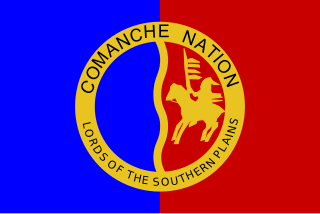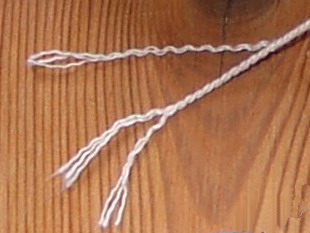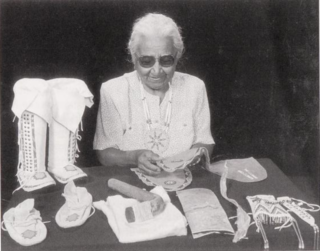Related Research Articles

A medicine man or medicine woman is a traditional healer and spiritual leader who serves a community of indigenous people of the Americas. Individual cultures have their own names, in their respective Indigenous languages, for the spiritual healers and ceremonial leaders in their particular cultures.

A pearl is a hard, glistening object produced within the soft tissue of a living shelled mollusk or another animal, such as fossil conulariids. Just like the shell of a mollusk, a pearl is composed of calcium carbonate in minute crystalline form, which has deposited in concentric layers. The ideal pearl is perfectly round and smooth, but many other shapes, known as baroque pearls, can occur. The finest quality of natural pearls have been highly valued as gemstones and objects of beauty for many centuries. Because of this, pearl has become a metaphor for something rare, fine, admirable and valuable.

The Crow, whose autonym is Apsáalooke, also spelled Absaroka, are Native Americans living primarily in southern Montana. Today, the Crow people have a federally recognized tribe, the Crow Tribe of Montana, with an Indian reservation located in the south-central part of the state.

The Comanche or Nʉmʉnʉʉ are a Native-American nation from the Great Plains whose historic territory consisted of most of present-day northwestern Texas and adjacent areas in eastern New Mexico, southeastern Colorado, southwestern Kansas, western Oklahoma, and northern Chihuahua. Within the United States, the government federally recognizes the Comanche people as the Comanche Nation, headquartered in Lawton, Oklahoma. The Comanche language is a Numic language of the Uto-Aztecan family. It was originally a Shoshoni dialect, but has diverged over time to become a separate language.

The Pawnee are a Central Plains Indian tribe that historically were based in Nebraska and Kansas and currently are based in Oklahoma. Today they are the federally recognized Pawnee Nation of Oklahoma, who are headquartered in Pawnee, Oklahoma. Their Pawnee language belongs to the Caddoan language family, and their names for themselves is Chatiks si chatiks or "Men of Men".

The indigenous peoples of the Americas comprise numerous different cultures. Each has its own mythologies. Some are quite distinct, but certain themes are shared across the cultural boundaries.

Kiowa people are a Native American tribe and an indigenous people of the Great Plains of the United States. They migrated southward from western Montana into the Rocky Mountains in Colorado in the 17th and 18th centuries, and finally into the Southern Plains by the early 19th century. In 1867, the Kiowa were moved to a reservation in southwestern Oklahoma.
The Apache are a group of culturally related Native American tribes in the Southwestern United States, which include the Chiricahua, Jicarilla, Lipan, Mescalero, Mimbreño, Ndendahe, Salinero, Plains and Western Apache. Distant cousins of the Apache are the Navajo, with whom they share the Southern Athabaskan languages. There are Apache communities in Oklahoma, Texas, and reservations in Arizona and New Mexico. Apache people have moved throughout the United States and elsewhere, including urban centers. The Apache Nations are politically autonomous, speak several different languages, and have distinct cultures.

UpanayanaJanai or janeau or poita or Yagnopavita or Bratabandha(Sanskrit: जनै, जनेऊ) is one of the traditional saṃskāras that marked the acceptance of a student by a guru and an individual's entrance to a school in Hinduism. The tradition is widely discussed in ancient Sanskrit texts of Hinduism and varies regionally. The sacred thread is received by the boy during this ceremony, that he continues wearing from left shoulder to the right crossing the chest thereafter. Generally this ceremony should be done before the age of 16.

Wampum is a traditional shell bead of the Eastern Woodlands tribes of Native Americans. It includes white shell beads hand fashioned from the North Atlantic channeled whelk shell and white and purple beads made from the quahog or Western North Atlantic hard-shelled clam. Before European contact, strings of wampum were used for storytelling, ceremonial gifts, and recording important treaties and historical events, such as the Two Row Wampum Treaty or The Hiawatha Belt. Wampum was also used by the northeastern Indian tribes as a means of exchange, strung together in lengths for convenience. The first Colonists adopted it as a currency in trading with them. Eventually, the Colonists applied their technologies to more efficiently produce wampum, which caused inflation and ultimately its obsolescence as currency.

A Japamala or mala is a string of prayer beads commonly used in Hinduism, Jainism, Sikhism, Buddhism, and other traditions for the spiritual practice known in Sanskrit as japa. They are similar to other forms of prayer beads used in various world religions and sometimes referred to in English as a "rosary".

Macramé is a form of textile produced using knotting techniques.

Twine is a strong thread, light string or cord composed of two or more thinner strands twisted, and then twisted together (plied). The strands are plied in the opposite direction to that of their twist, which adds torsional strength to the cord and keeps it from unravelling. This process is sometimes called reverse wrap. The same technique used for making twine is also used to make thread, which is thinner, yarn, and rope, which is stronger and thicker, generally with three or more strands.

An inro is a traditional Japanese case for holding small objects, suspended from the obi worn around the waist when wearing kimono. They are often highly decorated with various materials such as lacquer and various techniques such as maki-e, and are more decorative than other Japanese lacquerware.

Visual arts by indigenous peoples of the Americas encompasses the visual artistic practices of the indigenous peoples of the Americas from ancient times to the present. These include works from South America and North America, which includes Central America and Greenland. The Siberian Yupiit, who have great cultural overlap with Native Alaskan Yupiit, are also included.

Native American jewelry refers to items of personal adornment, whether for personal use, sale or as art; examples of which include necklaces, earrings, bracelets, rings and pins, as well as ketohs, wampum, and labrets, made by one of the Indigenous peoples of the United States. Native American jewelry normally reflects the cultural diversity and history of its makers, but tribal groups have often borrowed and copied designs and methods from other, neighboring tribes or nations with which they had trade, and this practice continues today. Native American tribes continue to develop distinct aesthetics rooted in their personal artistic visions and cultural traditions. Artists may create jewelry for adornment, ceremonies, and display, or for sale or trade. Lois Sherr Dubin writes, "[i]n the absence of written languages, adornment became an important element of Indian communication, conveying many levels of information." Later, jewelry and personal adornment "...signaled resistance to assimilation. It remains a major statement of tribal and individual identity."

Shell gorgets are a Native American art form of polished, carved shell pendants worn around the neck. The gorgets are frequently engraved, and are sometimes highlighted with pigments, or fenestrated.

The Juntunen Site, also known as 20MK1, is a stratified Prehistoric Late Woodland fishing village located on the western tip of Bois Blanc Island. It was listed on the National Register of Historic Places in 1978.

String is a long flexible structure made from fibers twisted together into a single strand, or from multiple such strands which are in turn twisted together. String is used to tie, bind, or hang other objects. It is also used as a material to make things, such as textiles, and in arts and crafts. String is a simple tool, and its use by humans is known to have been developed tens of thousands of years ago. In Mesoamerica, for example, string was invented some 20,000 to 30,000 years ago, and was made by twisting plant fibers together. String may also be a component in other tools, and in devices as diverse as weapons, musical instruments, and toys.

Alice Littleman was a Kiowa beadwork artist and regalia maker, who during her life time was recognized as one of the leading Kiowa beaders and buckskin dressmakers. Her works are included in the permanent collections of the National Museum of Natural History, the National Museum of the American Indian, the Southern Plains Indian Museum, and the Oklahoma Historical Society.
References
- ↑ Patricia D. Netzley, Apache Warrior, KidHaven Press, 2002, ISBN 978-0-7377-0989-6,
... a pouch filled with pollen from various plants that they thought would given them extra strength. This bag was tied to a cord called an izze-kloth, or Killer of Enemies, which was wrapped around the warrior's body from right shoulder to ... Braided from four strands of hide, the izze-kloth was made by a di-yin specializing in war ...
- ↑ Garrick Mallery, Picture-Writing Of The American Indians, Kessinger Publishing, 2006, ISBN 978-1-4286-0732-3,
... varieties of the izze-kloth or medicine cord of the Apache. A condensed extract of his remarks is as follows : These cords, in their perfection, are decorated with beads and shells strung along at intervals, with pieces of the sacred green chalchihuitl ...
- ↑ Allan A. Macfarlan, Paulette Jumeau Macfarlan, Knotcraft, the practical and entertaining art of tying knots, Courier Dover Publications, 1983, ISBN 978-0-486-24515-7,
... Each strand of these izze-kloth cords was dyed a different color. The colors generally used were yellow, blue, white, and black, and many of these necklaces were decorated at intervals with olivella or other shells ...
- ↑ James Hastings, Encyclopedia of Religion and Ethics: Part 2, Kessinger Publishing, 2003, ISBN 978-0-7661-3670-0,
... The izze-kloth, used by leaders and laity alike, is the most sacred emblem the Apache possesses, so much so that it must be ... both the izze-kloth and the medicine-hat losing their efficacy when in any way handled by an unbeliever ...
- ↑ Smithsonian Institution, Bureau of American Ethnology, Annual report of the Bureau of American Ethnology to the secretary of the Smithsonian Institution, Issue 9, Government Printing Office, United States Government, 1892,
... There is probably no more mysterious or interesting portion of the religious or 'medicinal' equipment of the Apache Indian, whether he be medicine-man or simply a member of the laity, than the 'izze-kloth' or medicine cord ... the Apache look upon these cords as so sacred that strangers are not allowed to see them, much less handle them or talk about them ...